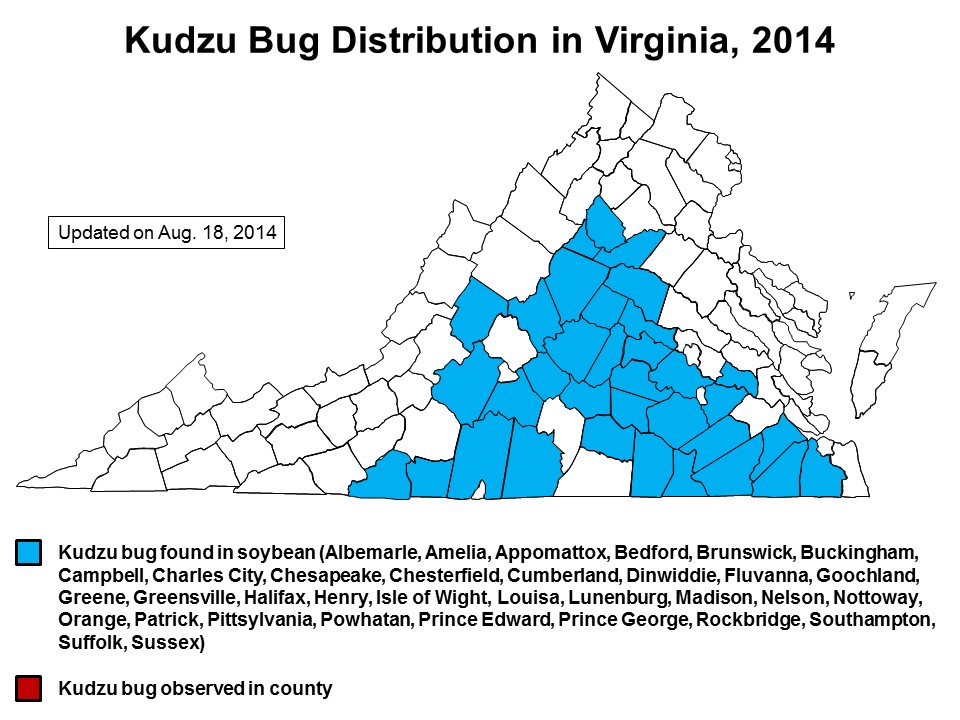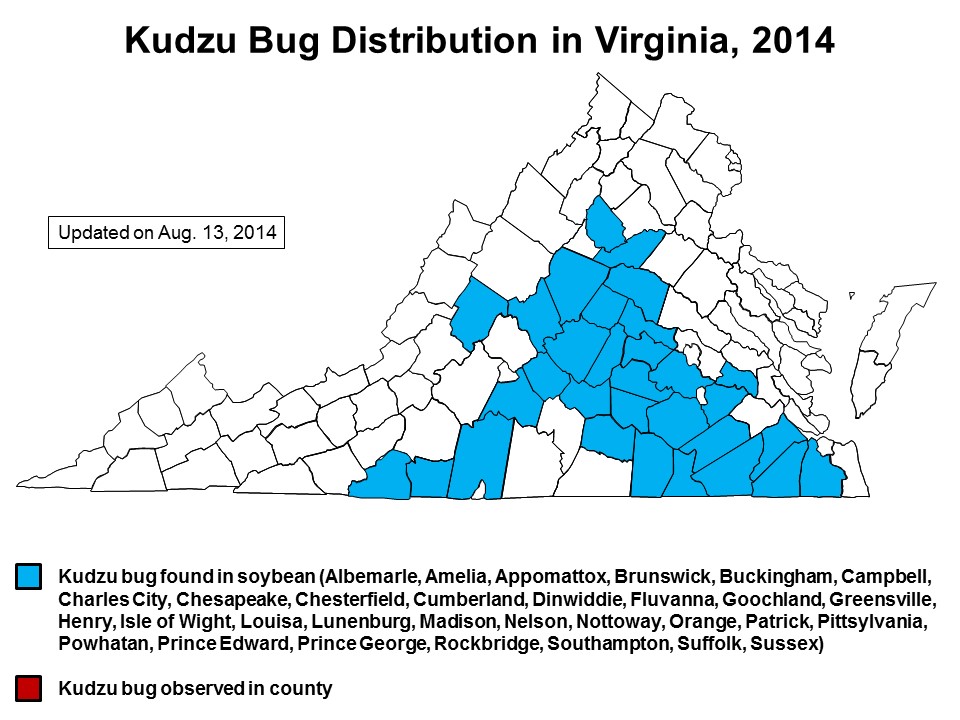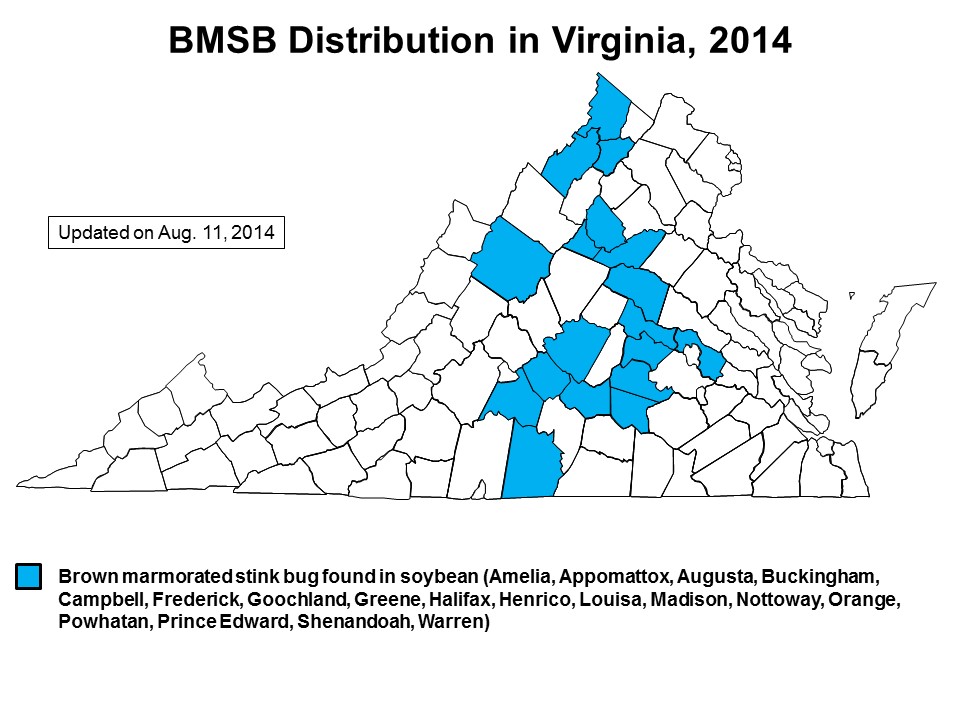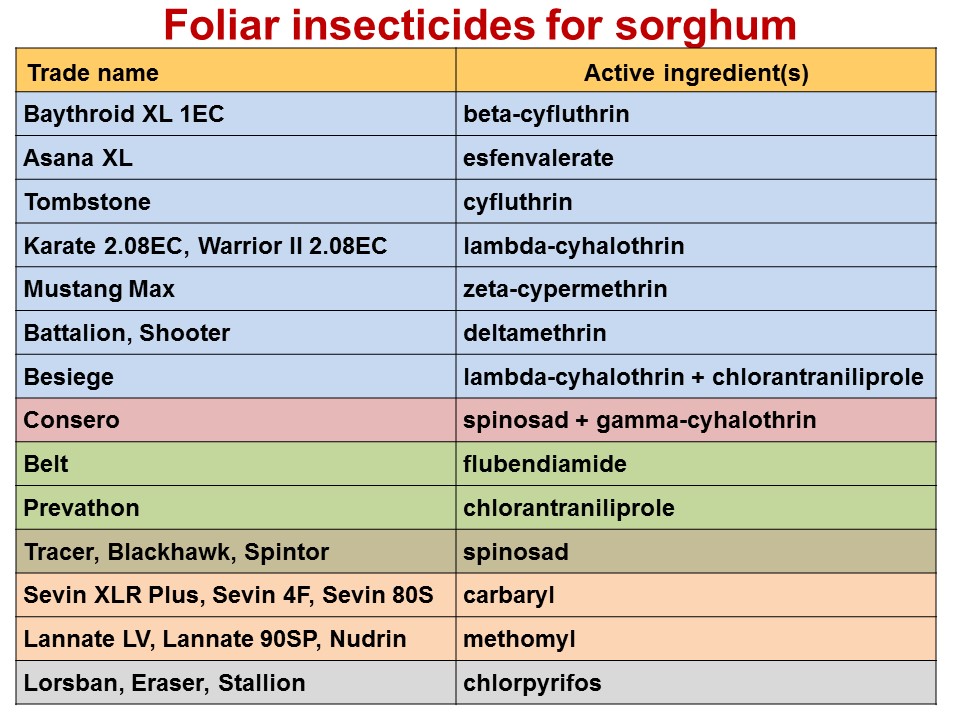Our soybean scouts detected kudzu bug in two new Virginia counties this past week (Halifax and Greene); both of these locations had low numbers. The highest numbers of kudzu bugs reported by our scouts for the past week were in a Pittsylvania soybean field (8 nymphs and 3 adults per 15 sweeps), followed by Goochland (4 adults per 15 sweeps) and Henry (3 nymphs and 2 adults per 15 sweeps). Additionally, VCE Agent Scott Reiter reported high numbers of kudzu bug adults along the edge in a Prince George soybean field that was bordered by kudzu (50 adults in 15 sweeps in the first 30 feet of field, diminishing to 3-4 adults per 15 sweeps at 100 feet from the field edge). Scott found other fields with 0-3 kudzu bugs in 15 sweeps.
Category Archives: Commodity
Peanut Disease Update – August 14, 2014
Sclerotinia blight risk has been, and continues to be, high this summer and timely fungicide applications based on advisories (Peanut-Cotton Infonet, http://webipm.ento.vt.edu/cgi-bin/infonet1.cgi) and scouting are needed to avoid devastating outbreaks of this disease. Unfortunately, it has been reported that Omega, the most effective fungicide for Sclerotinia blight control, is in short supply, and growers are looking for alternatives. At this point we are recommending Fontelis at a rate of 1.5 pints per acre. According to Barbara Shew, Extension Plant Pathologist at North Carolina State University, 1.5 pints per acre of Fontelis provide Sclerotinia control similar to one pint of Omega. Note that lower rates of Fontelis typically used for leaf spot control are not adequate for control of Sclerotinia. A follow-up Fontelis application should be made 2 to 3 weeks after the first application or according to the Sclerotinia blight advisory, but keep in mind that only two applications of this fungicide class (SDHI, group 7) should be made per year to minimize the risk of fungicide resistance. In fields with high Sclerotinia pressure, avoid using chlorothalonil (Bravo and generics) in August or early September for leaf spot control since this can increase the severity of Sclerotinia blight outbreaks. Alternatively, use strobilurin fungicides such as Abound or Headline or a triazole such as Provost for leaf spot control. However, the final leaf spot application of the season should be chlorothalonil for the purpose of fungicide resistance management. 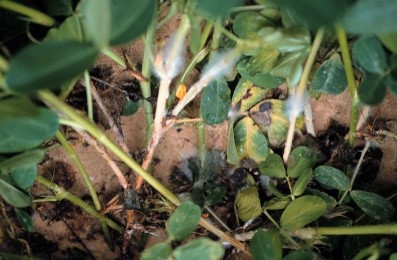
Southern Rust in Corn – Update
 Southern rust continues to be reported on corn in Virginia. Southern rust was first confirmed August 3 on corn samples from Chesapeake and Suffolk. Since then, reports of southern rust have been made from Sussex and Albermarle counties, and it is likely that the pathogen is throughout much of the state. Yield of corn at or near the dent stage is unlikely to be impacted by the disease, but late planted corn in fields with good yield potential (120 bu/ac +) may need to be protected with a foliar fungicide. Strobilurins are good preventative fungicides whereas triazoles are recommended once sporulation is observed in a field due to their curative activity. A combination fungicide is a good option as long as a strobilurin fungicide has not been applied previously. Wet, warm weather favors disease development. Once sporulation occurs, symptoms of rust are relatively obvious. Lesions start out as raised, blister-like pustules then break open to reveal orange spores. Samples of corn plants with symptoms of southern rust can be submitted to the disease clinic at the Virginia Tech Tidewater AREC (contact Dr. Hillary Mehl, hlmehl@vt.edu).
Southern rust continues to be reported on corn in Virginia. Southern rust was first confirmed August 3 on corn samples from Chesapeake and Suffolk. Since then, reports of southern rust have been made from Sussex and Albermarle counties, and it is likely that the pathogen is throughout much of the state. Yield of corn at or near the dent stage is unlikely to be impacted by the disease, but late planted corn in fields with good yield potential (120 bu/ac +) may need to be protected with a foliar fungicide. Strobilurins are good preventative fungicides whereas triazoles are recommended once sporulation is observed in a field due to their curative activity. A combination fungicide is a good option as long as a strobilurin fungicide has not been applied previously. Wet, warm weather favors disease development. Once sporulation occurs, symptoms of rust are relatively obvious. Lesions start out as raised, blister-like pustules then break open to reveal orange spores. Samples of corn plants with symptoms of southern rust can be submitted to the disease clinic at the Virginia Tech Tidewater AREC (contact Dr. Hillary Mehl, hlmehl@vt.edu).
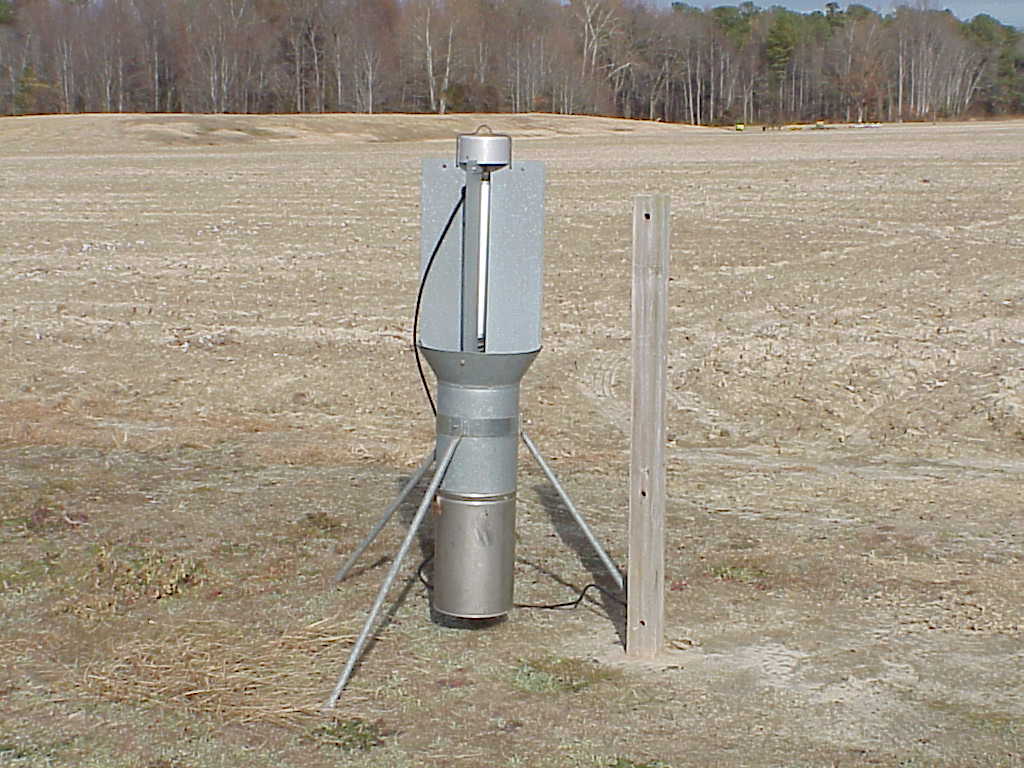
Black light trap catches for the week ending August 14, 2014
Corn earworm moth catches are increasing; please click on “BLT_14_Aug_2014” below for your local trap catches of this insect and also the brown marmorated stink bug. Thanks to the following for their reports this week: David Moore, Keith Balderson, Watson Lawrence, Kelvin Wells, Mark Kraemer, Chris Drake, Mary Beahm, Mike Parrish, Janet Spencer, and Ames Herbert and his entomology team.
Update on kudzu bug and brown marmorated stink bug
We are providing updated maps of the distribution of kudzu bug and brown marmorated stink bug in Virginia. Although we have added a few new counties since last week, overall the populations of both of these pests are very low compared with last year. To our knowledge, no soybean fields have even come close to reaching threatening levels or thresholds.
Most kudzu bug egg masses that we are finding have already hatched indicating that the second generation is occurring. This pest has only two generations so if this second generation stays small, as it appears, we may not have to treat any fields this year.
Brown marmorated stink bug levels are very low. Although a few can be found in many fields, none are reaching high levels. All of this is good news for growers. But, the season is far from over so stay vigilant.
Cotton aphids found in North Carolina
I have gotten several calls reporting that aphid infestations are occurring in some cotton fields in northeast North Carolina. To my knowledge, none have been reported from Virginia, but growers should be alerted.
In the ‘old’ days before Bt cotton, we typically treated cotton twice in August with pyrethroids for bollworm. During those years is was not uncommon to see aphid ‘flares’ after those two sprays. We know from ongoing research in soybean that pyrethroids are pretty devastating to most natural enemies (the many insects and spiders that attack and eat pest species). We presumed that the bollworm sprays were suppressing natural enemies and ‘allowing’ cotton aphid populations to build. So, is that what is going on this year in cotton? We cannot be sure or course, but more growers are treating two, even three times for plant bugs and stink bugs, and in most cases they are using pyrethroids. Are these reported aphid flare-ups related to multiple, close-interval pyrethroid sprays? We cannot be sure but if this is the beginning of a trend, we need to reconsider some things, like—are all of the plant bug and stink bugs sprays warranted and based on actual insect pressure; could some be eliminated; should we be using neonicotinoid insecticides (which can help suppress aphids), either tank mixed or as combination products, for one or more of these sprays?
All good questions that will have to be addressed if the aphid situation gets worse. Flaring a bad aphid problem will require more sprays, more money, and more bother. We need to do whatever we can to prevent this problem.

Headworms showing up in sorghum
We are getting reports of a few worms in young sorghum heads. ‘Headworms’ are key insect pests of sorghum in Virginia and can include a complex of species but primarily corn earworm and fall armyworm. In years with heavy corn earworm moth flights and infestations in soybean and peanut, sorghum is also at high risk of being infested. Although we are experiencing a generally weak corn earworm moth flight so far this year, because sorghum is such an attractive host, fields should be checked.
Stay in touch with the status of the corn earworm flight via the new Virginia Ag Pest and Crop Advisory Blog (http://blogs.ext.vt.edu/ag-pest-advisory/). You can view postings at this website, or if you want to receive the weekly advisories via email, go to the Blog site and sign up.
So what are the worm thresholds for sorghum, what is the best way to scout, and what products are labeled for control—all good questions.
We have learned that the best way to sample sorghum heads for worms is with a 5-gal bucket, preferably white. Relying on visual inspection of heads does not work well because you cannot easily see the small worms or even big ones if they bury themselves deep into the heads. Bending the heads into the bucket and vigorously shaking/slapping them does the job—dislodges the worms into the bucket. Worm infestations are not always uniformly distributed across a field so we recommend sampling 10 heads in 10-20 different locations in a field.
Because of differences in variety, planting date, soil moisture, and other factors, different fields may have heads at different maturity stages so keep this in mind and focus scouting efforts on fields with heads in these most susceptible stages—from soon after flowering when seeds begin to form until seed are hardened.
The most common threshold across the southern and central states is to treat when worms average 2 or more per head. This is a good starting point.
A final note, a broadcast spray pattern is probably the least effective way to achieve a good worm control. Treatments will be more effective if you can set up a boom with a nozzle over the row, or multiple nozzles to direct the spray to heads, only, and deliver 12-15 gal per acre. The table below provides a fairly comprehensive list of insecticides labeled for use in sorghum. We have generally achieved the best control when we have included a non-pyrethroid like Belt, Prevathon, Besiege, or Blackhawk. Check labels for rates and other use information.

Late blight found on Tomato in Rappahannock County, Virginia
The following information is from Elizabeth Bush with the Virginia Tech Plant Disease Clinic: Late blight has been confirmed on tomato in Washington, VA by the Virginia Tech Plant Disease Clinic. Potato and tomato growers (especially in the northern part of the Commonwealth) should take precautionary actions and increase scouting. Cool and wet conditions favor development of this disease and fungicide sprays should be in place before the disease is present in a field or garden. For more information on late blight and late blight management refer to the Extension publication available at http://pubs.ext.vt.edu/ANR/ANR-6/ANR-6_pdf.pdf . Late blight was previously identified in Loudoun County, VA on July 22.
Black light trap catches for the week ending August 7, 2014
Corn earworm moth catches increased at nearly all stations this week, with means ranging from less than one to 29 moths per night. Brown marmorated stink bug mean captures ranged from zero to 19 per night, with Charles City and Petersburg at the high end. Please click on the link beneath this paragraph that says “BLT_7_Aug_2014” to see the Tables for detailed captures of these two pests. A couple of reports came in shortly after the Tables were posted–the Essex location had 0.6 corn earworm moths per night and no BMSB; the Chesapeake black light trap caught one corn earworm moth over two nights of trapping. Thanks to the following for their reports this week: Scott Reiter, Mary Beahm, Helene Doughty, Kelvin Wells, Chris Drake, John Allison, Janet Spencer, Mark Kraemer, Dorothy Baker, David Moore, Keith Balderson, Watson Lawrence, and Ames Herbert and his entomology team.
Helicoverpa zea (aka corn earworm, bollworm) resistance monitoring update–Aug. 7, 2014
Our corn earworm/bollworm moth catches went up this week allowing us to conduct adult vial tests on 128 moths. Vials were treated with the standard 5 microgram rate of cypermethrin (a pyrethroid insecticide), or acetone (the untreated check). This week, 39.4% of moths survived the test, which is high. The season-long average is now 35% survival (based on 190 moths evaluated) and is higher than what we saw in 2013 (see graphs, below). Survivorship at this level indicates that non-pyrethroids may need to be considered when an insecticide is needed for this pest in some regions, so please keep this in mind when scouting and then making management decisions in the upcoming days.

